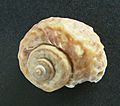Mud-flat snail facts for kids
Quick facts for kids Mud-flat snail |
|
|---|---|
 |
|
| A shell of Amphibola crenata | |
| Scientific classification | |
| Synonyms | |
|
The Mud-flat snail (called tītiko by the Māori people) is a special kind of snail. It breathes air, which is unusual for a snail that lives near the sea. This snail has a hard "door" called an operculum that can close its shell. It lives in a unique place that's not quite land and not quite ocean, like muddy areas where the tide comes in and out. You can find these interesting snails commonly in New Zealand.
Contents
What Does the Mud-Flat Snail Look Like?
The Mud-flat snail has a thick shell that grows to about 20 mm in size. That's about the length of a small button!
Where Does It Live and How Does It Breathe?
The Mud-flat snail is quite unique because it seems to be a link between snails that live in the ocean and those that live only on land. Its special breathing organ, called a mantle, works like a lung. This means it doesn't need to be underwater for long. It only gets covered by sea water for about an hour during high tide.
This snail is one of the very few air-breathing snails that live near the sea and also have an operculum. It also has a special baby stage called a veliger larva.
What Does It Eat?
The Mud-flat snail is a "detritus" or "deposit feeder." This means it eats tiny bits of decaying plants and animals, as well as bacteria and diatoms, which are tiny algae. It finds this food on the surface of the sand. After eating, it passes out the sand and a slimy substance. This substance then becomes a rich food source for other bacteria.
The Mud-Flat Snail and People
In the past, the Mud-flat snail was an important food source for the Māori in New Zealand.
Even though there were many snails, getting the meat out was hard work. People often preferred to collect other shellfish like pipi, which were easier to prepare. The snail's shell and its cap (operculum) made it difficult to get to the meat inside. Traditionally, people had to smash the shell to get the soft parts out.
Later, in the 1950s and 1960s, people found a clever way to eat them. They used a safety pin! The safety pin had the perfect bend and sharp point to get past the snail's cap and pull out the tasty meat. This made eating the snails much easier and more enjoyable.
Today, mature Mud-flat snails (around 25mm) are not as common as they used to be. While the species is not considered endangered, finding the larger, edible ones is now quite rare. Smaller snails (about 10mm) can still be found in some areas.
Images for kids




